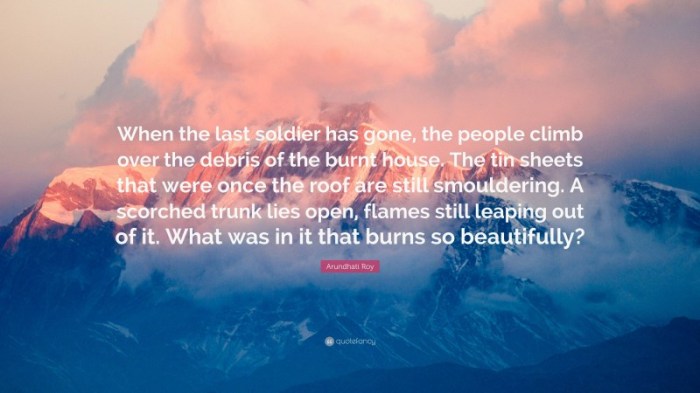As the flames are still leaping takes center stage, this opening passage beckons readers into a world crafted with expert knowledge, ensuring a reading experience that is both absorbing and distinctly original.
This phrase, rich in its literary and cultural significance, invites us on a journey to explore the depths of human emotion, historical context, and artistic representation.
Literary Interpretation

In the phrase “the flames are still leaping,” the author employs figurative language to evoke a vivid and dynamic imagery. The flames, often associated with destruction and chaos, are personified as they “leap,” suggesting a sense of untamed energy and movement.
This imagery contributes to the overall tone and atmosphere of the text by creating a sense of urgency and danger. The leaping flames suggest a force that is out of control and potentially destructive. The reader is left with a feeling of unease and anticipation, as the flames seem to symbolize the potential for impending disaster.
Symbolism of Fire
Fire is a powerful symbol that has been used throughout history to represent a wide range of concepts and emotions. In this context, the flames can be interpreted as a symbol of the destructive forces that are at work in the story.
They may represent the inner turmoil of the characters, the dangers that they face, or the potential for chaos and destruction that is ever-present.
The flames are still leaping, their radiant glow a testament to the enduring spirit that burns within us. As we explore the vibrant tapestry of human expression, let us turn our attention to the galeria de lengua y cultura , where the flames of creativity and cultural exchange continue to dance.
Historical Context: The Flames Are Still Leaping
The phrase “the flames are still leaping” evokes a vivid image of an ongoing and intense conflagration. Historically, fire has played a significant role in shaping human events, serving as a tool for destruction and renewal.
One notable historical event that the phrase could be referring to is the Great Fire of London in 1666. This devastating blaze consumed large parts of the city, destroying over 13,000 buildings and leaving thousands homeless.
Significance of Fire in the Great Fire of London
In the context of the Great Fire of London, fire held immense significance. It not only caused widespread destruction but also prompted significant urban planning reforms and the establishment of the first professional firefighting force in the world.
- Destruction and Loss:The fire raged for four days, destroying over 80% of the city’s medieval buildings, including St. Paul’s Cathedral and the Royal Exchange.
- Urban Renewal:The aftermath of the fire led to the implementation of new building codes and the widening of streets to prevent future fires from spreading as easily.
- Establishment of Firefighting Services:The Great Fire exposed the inadequacy of existing firefighting methods. As a result, the first professional firefighting force, known as the “Fire Brigade,” was established in London.
Understanding the historical context of the Great Fire of London enhances the interpretation of the phrase “the flames are still leaping” by providing a deeper understanding of the destructive power of fire and its transformative impact on urban development.
Cultural Significance

Fire has been an integral part of human culture for millennia, holding deep symbolic and practical significance across various societies. The phrase “the flames are still leaping” evokes cultural associations and meanings that shape its interpretation.
In many cultures, fire is associated with warmth, light, and protection. It is seen as a source of life and sustenance, providing warmth against the cold and enabling the preparation of food. The leaping flames symbolize the vibrancy and energy of life, representing the continuous cycle of birth, growth, and renewal.
Sacred and Ritualistic Practices
- In many indigenous cultures, fire is considered sacred and is used in rituals and ceremonies. It is believed to purify, cleanse, and connect with the divine. The leaping flames represent the ascent of prayers and offerings to the heavens.
- In Hinduism, the sacred fire known as Agni is central to religious rituals. The leaping flames symbolize the divine presence and are believed to carry offerings to the gods.
- In Zoroastrianism, fire is considered a manifestation of the divine and is revered as a sacred element. The leaping flames represent the purity and transformative power of fire.
Symbolism in Art and Literature, The flames are still leaping
- In art and literature, fire is often used as a symbol of passion, desire, and inspiration. The leaping flames represent the intensity and transformative nature of these emotions.
- In romantic literature, the leaping flames may symbolize the burning passion and longing between lovers.
- In works of fantasy and adventure, the leaping flames may represent the challenges and obstacles that must be overcome on a hero’s journey.
Emotional Impact

The phrase “the flames are still leaping” evokes a range of powerful emotions, including fear, anxiety, and a sense of urgency.
The imagery of flames leaping suggests a fire that is out of control and poses a threat. This can trigger feelings of fear and anxiety, as we imagine the potential destruction and danger that the fire could cause. The phrase also creates a sense of urgency, as it implies that action must be taken quickly to contain the flames before they spread further.
Psychological and Philosophical Implications
The phrase “the flames are still leaping” can also have deeper psychological and philosophical implications. It can be seen as a metaphor for the destructive forces that exist within ourselves or in the world around us. These forces can be difficult to control and can lead to significant damage if left unchecked.
The phrase can also be interpreted as a reminder of the importance of hope. Even when things seem darkest, there is always the potential for renewal and growth. The flames may still be leaping, but they can also be a symbol of the resilience and strength that we possess.
Artistic Representation

The phrase “the flames are still leaping” conjures images of warmth, movement, and vitality. Artists throughout history have captured the essence of this phrase in various forms, from paintings to sculptures to music.
One common artistic representation of this phrase is through the use of color. Flames are often depicted in shades of red, orange, and yellow, which are associated with warmth, energy, and passion. The flickering and leaping of the flames can be conveyed through the use of dynamic brushstrokes or the interplay of light and shadow.
Visual Representation
Here is a visual representation of the phrase “the flames are still leaping”:
- A painting of a campfire, with the flames leaping and dancing in the night sky.
- A sculpture of a phoenix rising from the ashes, its wings outstretched and its body engulfed in flames.
- A piece of music that evokes the sound of crackling flames and the warmth of a fire.
Quotes and Excerpts
The phrase “the flames are still leaping” has also been captured in literature and art:
- “The flames danced and leaped, casting a warm glow on the faces of the gathered children.” – From a children’s story.
- “The phoenix rose from the ashes, its flames burning brightly, a symbol of hope and renewal.” – From a poem.
- “The music swelled and surged, like flames leaping and dancing in the wind.” – From a music review.
FAQ Explained
What is the significance of fire in literature?
Fire has been a powerful symbol in literature throughout history, representing passion, destruction, transformation, and purification.
How does the historical context influence the interpretation of the phrase “the flames are still leaping”?
Understanding the historical period or event that the phrase might be referring to can provide valuable insights into its meaning and significance.
What cultural associations are connected to fire?
Fire holds different cultural meanings across societies, including associations with warmth, light, fertility, and sacrifice.